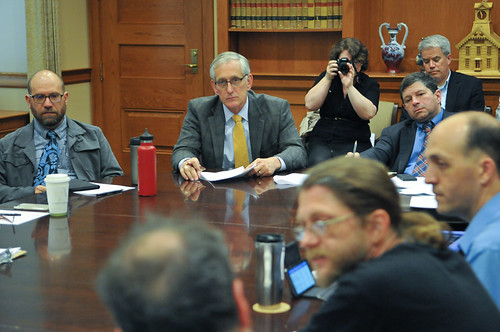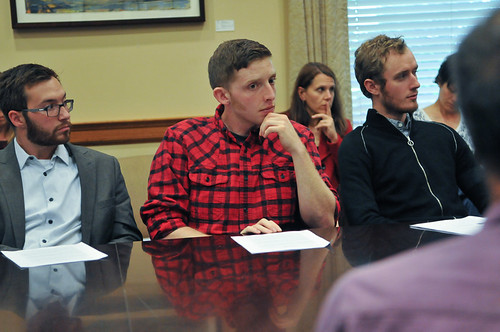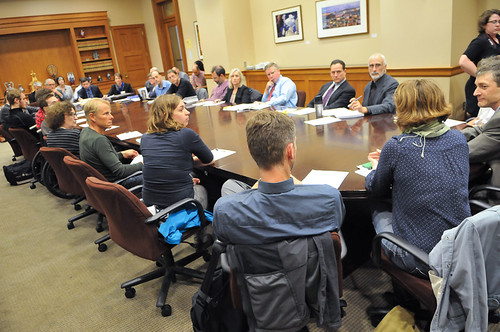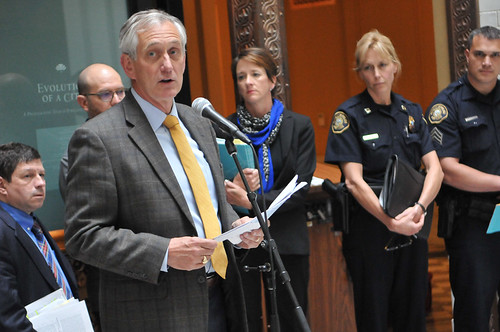
(Photos by J. Maus/BikePortland)
After weeks of tragedy, protests, and public pressure that has followed a spate of collisions involving bicycle riders, Portland Mayor Charlie Hales and City Commissioner Steve Novick hosted a meeting at city hall yesterday to discuss how to make our streets safer. The meeting was followed by a press conference which was beamed live by several local TV stations.
“Our kids are just trying to get to school, and our ‘safe routes to school’ aren’t safe. There’s no police report about that.”
— Kathleen Youell
With all the attention on the issue and a swell of public support to do something about it, yesterday presented Hales and Novick — two politicians who have been strangely silent about bicycling since taking office in 2013 — with a golden opportunity to move the needle. The problem has come into clear focus this past month: Our streets do not serve people who bike or walk with the same level of access and comfort as those who drive.
Yesterday’s meeting was a sign (albeit small) that Hales and Novick might finally be ready to sink their teeth into this issue. To help them find solutions they invited over two dozen people to yesterday’s meeting. They included the usual array of advocates, city and council staff, and grassroots activists. There were also a few new faces: Kathleen Youell was there to represent people who bike with kids; and Alistair Corkett, the man whose leg was severed off in a horrific collision on SE Powell on May 10th, made a statement just by rolling in on his wheelchair.
Invited guests sat around a large conference table in the Rose Room and Hales and Novick sat side-by-side at one end (Hales was flanked by Bicycle Transportation Alliance Executive Director Rob Sadowsky and Portland Bureau of Transportation Director Leah Treat sat next to Novick).
During the round of introductions, Corkett (who showed up with his mom Julia Corkett and two friends) elicited a few anxious chuckles when he said, “I’m Alistair Corkett, I got hit by a truck.”
Advertisement
At the outset, Hales said his goal in the meeting was to, “Elicit as many ideas from you about what we can do more of an what we can do better to improve the safety of our streets.” There was no structure or format to the meeting and people pretty much just spoke out whenever they had something to say.
“Much of this is not about infrastructure. It’s caused by poor choices, bad decisions, or pure driver error.”
— Rob Sadowsky, BTA
Short opening statements were made by Novick and Treat. Novick reminded everyone about the city’s bill in Salem (HB 2621) to place unmanned photo radar on “high crash corridor” streets. Treat announced that she has formally asked the Oregon Department of Transportation for more local authority to set lower speed limits (ODOT currently controls speed limits and only changes them by request on a case-by-case basis).
Speed was the biggest topic of conversation at the meeting. There’s a strong desire among both city staff and activists to lower speed limits across the city. Other ideas were to place traffic diverters on neighborhood greenways, step up funding for the Safe Routes to Schools program, do more enforcement, commit to Vision Zero, and start some sort of PSA/marketing campaign that would encourage safer behaviors.
Some argued that new and better infrastructure is meaningless if people don’t start obeying the law, others said the exact opposite.
“Much of this is not about infrastructure,” the BTA’s Sadowsky said, “It’s caused by poor choices, bad decisions, or pure driver error.” Sadowsky’s main push was for the City of Portland to fully embrace Vision Zero (the BTA passed around this list of recommendations).
“I’d like to see speed framed the same way that drunk driving and seatbelts have been framed in the past.”
— Noel Mickelberry, Oregon Walks
A friend of Alistair Corkett’s provided the counterpoint. “[Besides the Springwater Corridor] there’s nowhere I can ride my bike that’s closed to traffic. We’re not going to have zero collisions until we separate people. Every day I have to think about how my best friend lost his leg and I have to be overly conscious when I ride. It’s going to come down to infrastructure change. We have to make people drive safer.”
There was quite a bit of talk about what Sadowsky referred to as a “broad-based marketing campaign” that is tentatively titled, “Travel With Care.” An official “pledge” to drive safer was also mentioned. I followed up with Mayor Hales after the meeting and he said he would “look at signing this pledge ourselves for our own workers.” “We have 100s of vehicles on the street right now, so I think if we started with our own workforce, that would be a nice start.”
On a similar note, Oregon Walks Executive Director Noel Mickelberry told Mayor Hales that she’d like to see speed framed the same way that drunk driving and seatbelts have been framed in the past. (That idea stuck, as Hales repeated it to the news cameras at the press conference.)
Data was also a big point of discussion. Portland Fire Chief Erin Janssens said they’ve been combing through bicycle collisions data, and BTA Advocacy Director Gerik Kransky said if we had better data about bike collisions it could lead to more federal funding. But Kath Youell, a mom of two young children who totes them around in a cargo bike said data should not be the only focus: “Our kids are just trying to get to school, and our ‘safe routes to school’ aren’t safe. There’s no police report about that.”
Attendee Lillian Karabaic (who wears many hats including producer of the BikePortland Podcast and development manager for the Community Cycling Center) pointed out the assembled leaders don’t represent the entire community. “I want everyone to note the demographic makeup of this room,” she said, “People of color are 50% more likely to be injured in vulnerable roadway user crashes and the majority of people injured in pedestrian crashes are under 18. … The people most likely to be affected by the changes we’re talking about are not at this table.”
Data also played a role in the discussion about using traffic diverters on lower auto counts on neighborhood greenways. Several attendees voiced strong support for doing more traffic diversion — which is something PBOT is traditionally reluctant to do.
SE Uplift Neighborhood Transportation Chair Terry Dublinski-Milton said the city should use movable planters as temporary diverters that could be moved “from greenway to greenway.” “Clinton, Ankeny, 15th, Going, Michigan all need them and it would be a low-cost, easy fix.”
In an interview after the press conference, I asked Hales if he would give PBOT the authority to try a temporary diversion project like the one Dublinski-Milton suggested. “Yes,” he said, “Rather than study something to death, I’d love to try more of this experimental approach. If it works, then we can move more quickly to permanent installation.”
In the end, Vision Zero was the idea that won the day.
Advocates told me that Mayor Hales’ strong embrace about it was the best news of the day. After the meeting, here’s what Hales told the media at the press conference:
“We share a vision and it has a name — that vision is zero. Zero crashes that take away the lives of our citizens and all the hopes that go with them. That’s an obviously ambitious goal when we share streets with everything from trucks to skateboards; but it is our vision.”
Hales’ Chief of Staff Joshua Alpert told me they plan to set up a Vision Zero committee to make sure the implementation work actually happens once the heat around these recent collisions cools off.
Debra Dunn, former president of the Oregon Trucking Association (and now an industry consultant) said she supports it too. “I think it’s critically important for trucking industry to jump on board with vision zero.”
With broad support for the concept, Hales is poised to bring a vision zero commitment to city council. “Rob [Sadowsky] called on city council to formally adopt vision zero,” he said, “and I think we should. I think we should adopt it as our goal, which means other bureaus, besides PBOT would have to make that their goal.”
Other than the strong talk about vision zero and admonitions about speed and safer behaviors, there was very little concrete action announced yesterday. I left the press conference disappointed. Yes, we might have taken a few baby steps, but we are no longer babies and it feels like an opportunity to truly move the needle was squandered.
I saw Alistair Corkett in front of City Hall after the press conference and asked him what he thought.
“It wasn’t what I was hoping for, but it was what I expected,” he said. “I feel like a lot of it was bureaucrats who look at data. A lot of the people in that room were out of touch.” Then he added that the meeting was, “A push in the right direction and it was a start.”
Later on his Instagram account, he was more candid in a comment to friends: “pointless bureaucracy everybody.”
Now it’s our job to prove him wrong.
I look forward to reporting more about the concrete actions Mayor Hales and Commissioner Novick plan to take next.
UPDATE, 2:30 pm: The Mayor has released a statement outlining “bike safety action items.”
NOTE: The original version of this post stated that Kath Youell felt “data should be the only focus.” That is incorrect. It has been corrected to state that she thinks, “data should not be the only focus.” I regret the error.
Correction 6/4: The original version of this post misquoted Lillian Karabaic.




